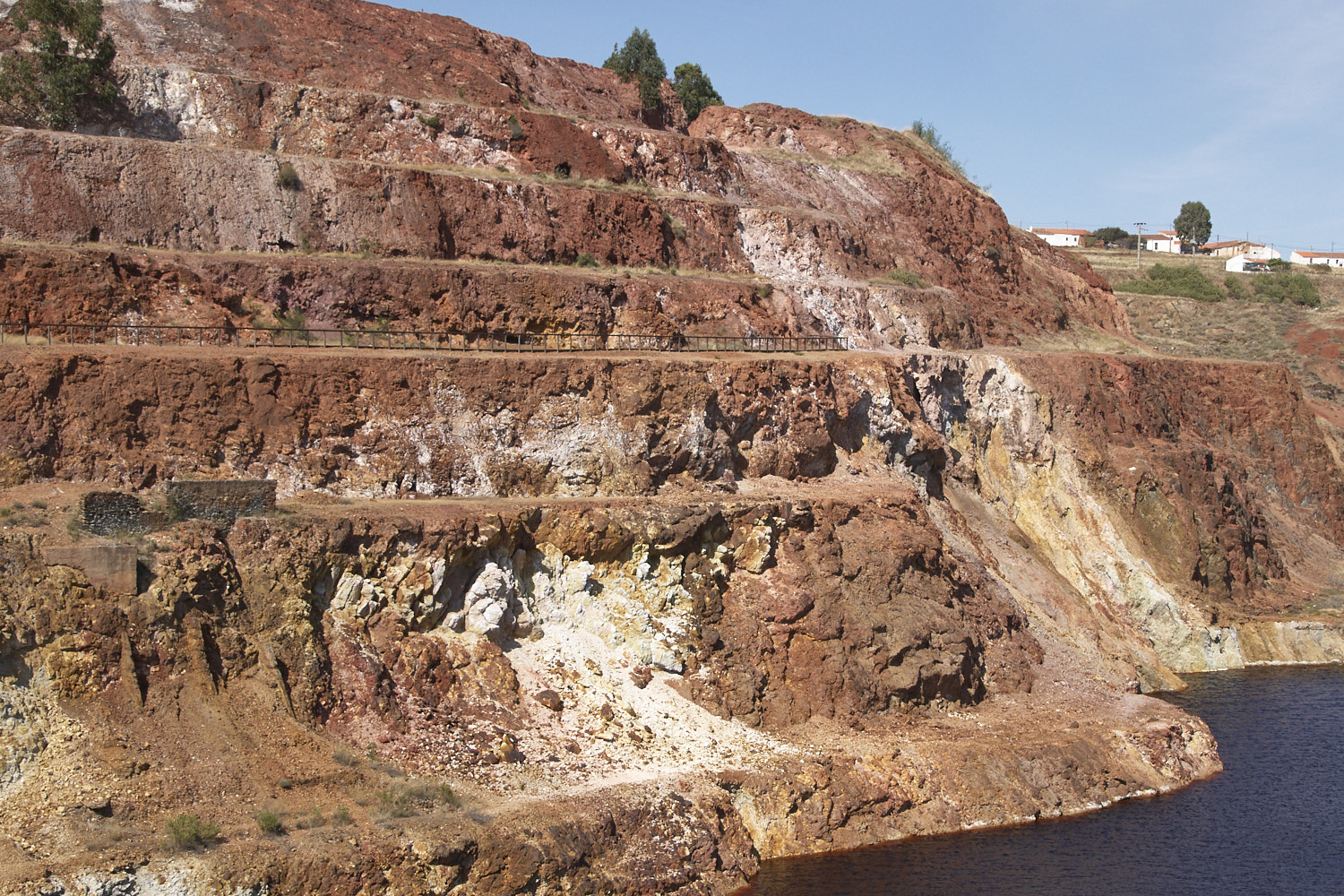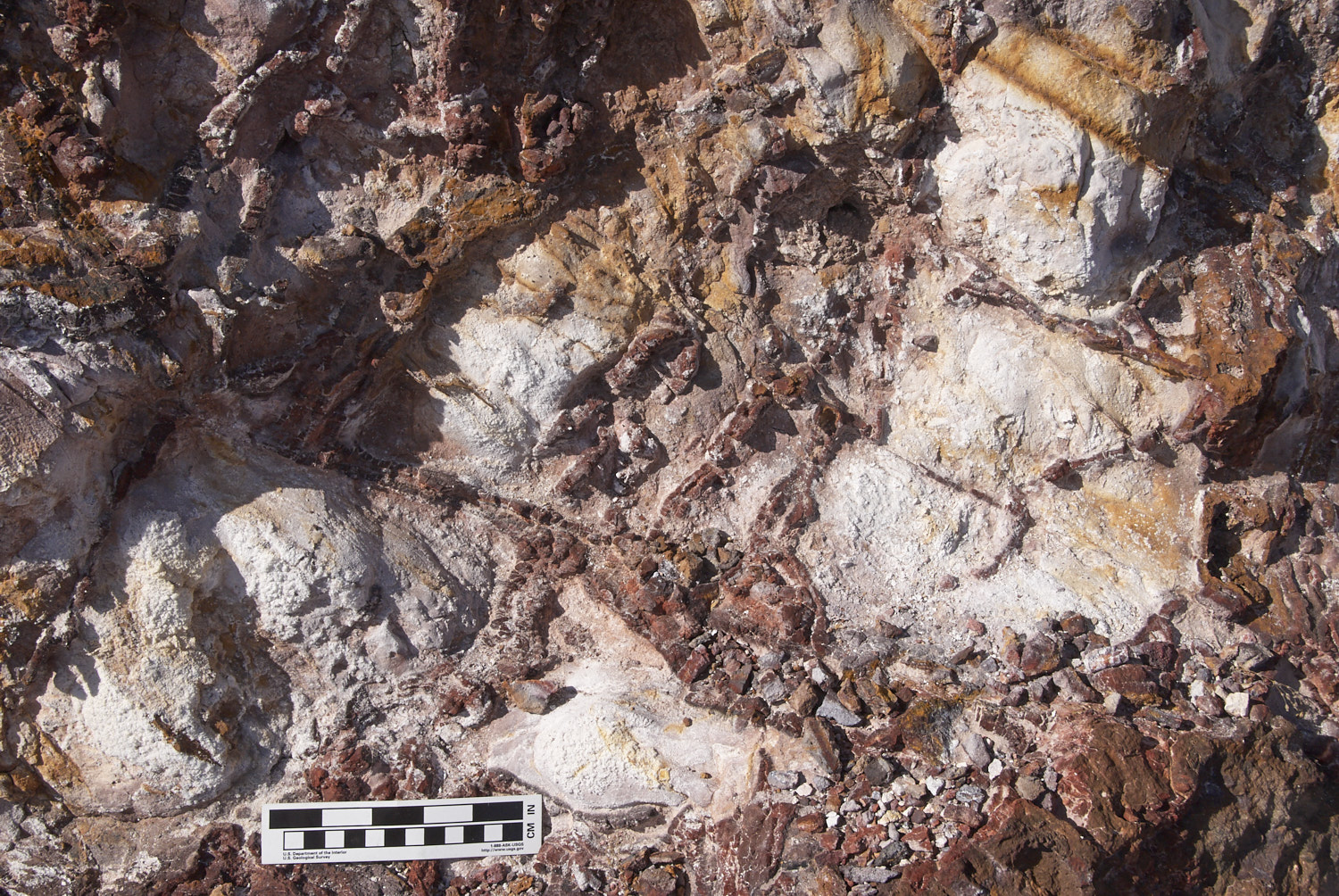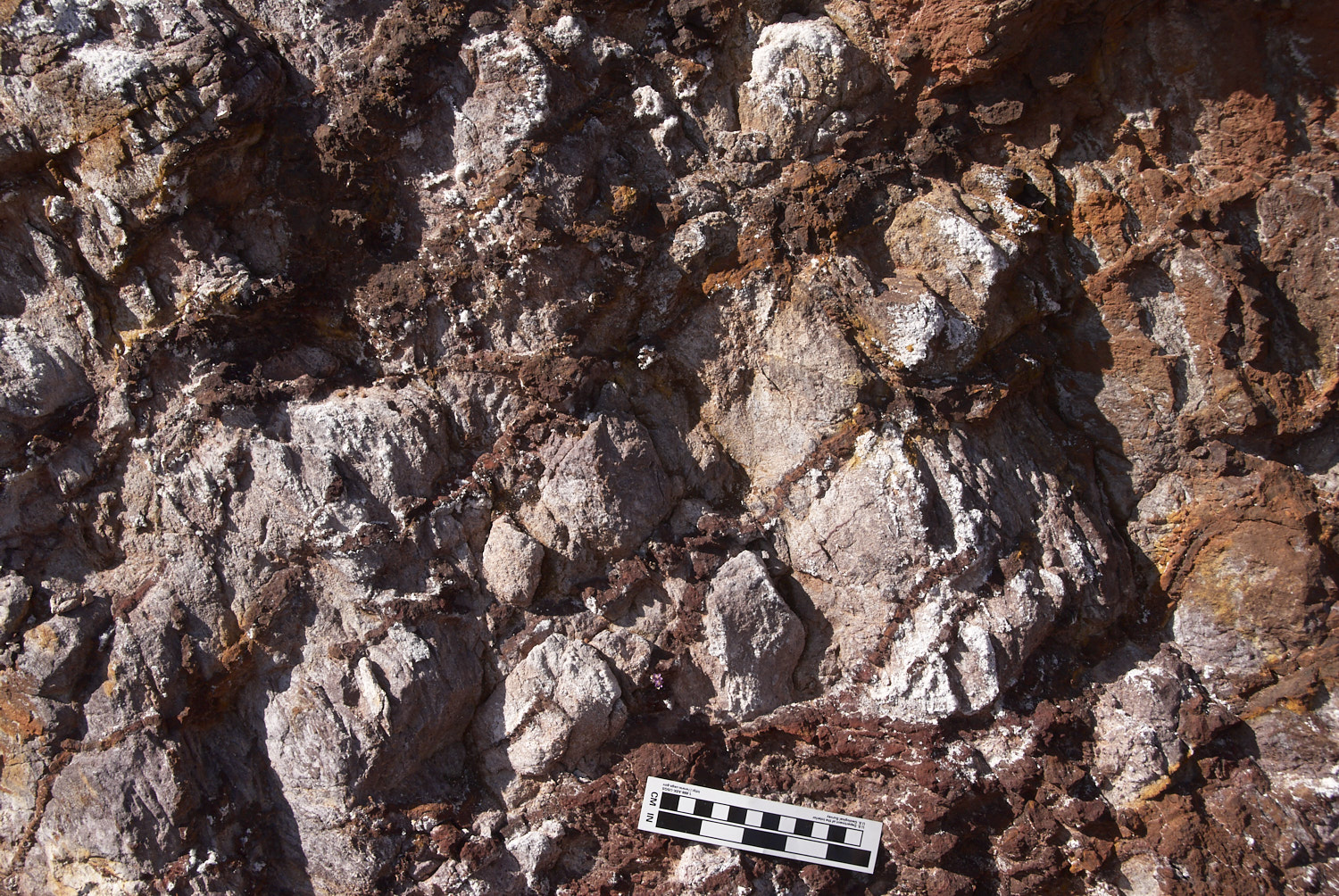justificação do valor científico
The São Domingos orebody (mined out) was composed of a single, subvertical, massive sulphide lenticular body, striking approximately E-W, about 537m along strike, and with a maximum thickness of 45m (Webb 1958, Carvalho 1971). The position of the orebody is within the top of a sequence composed of black shales and acid, basic and intermediate volcanics of the Volcanic-Sedimentary (VS) Complex of the Iberian Pyrite Belt. The orebody is rooted in a stockwork, well developed on the northern side of the open pit, characterised by a network of centimetric, anastomosing, pyrite-quartz veinlets (Matos et al. 2006, Oliveira et al. 2006, Matos et al. 2008, Pereira et al. 2008). The stockwork represents channelways of hydrothermal fluids responsible for the ores, which produced hydrothermal alteration with normal zonation (Barriga, 1990), with chlorite and quartz in proximal domains and sericite±quartz in more peripheral domains. The structural unit containing the VS Complex and the sulphide orebody is bound by overthrusts, with left-lateral displacement, which bring older (Upper Fammenian) rocks, of the Phyllite-Quartzite (PQ) Group, to a position above the VS Complex.
São Domingos is a geosite of international value in view of the presence of a stockwork, and volcanic rocks with a clearly understood setting, largely because of privileged outcropping conditions. There is a geological trail defined through the geosite, since 2005, produced by LNEG (former INETI), the Mértola Municipality, and CCDR Alentejo.
Álvarez-Valero, AM, Pérez-López, R, Matos, J, Capitán, MA, Nieto, JM, Sáez, R, Delgado, J, Caraballo, M. (2008). Potencial environmental impact at São Domingos mining district (Iberian Pyrite Belt, SW Iberian Peninsula): evidence from a chemical and mineralogical characterization. Environmental Geology, 55, 1797-1809.
Barriga FJAS, 1990. Metallogenesis in the Iberian Pyrite Belt. In: RD Dallmeyer, E Martinez (Eds), Geology of Hercynian Iberia, Springer - Verlag, p 369-379
Carvalho, D. (1971) Mina de S. Domingos. Jazigos Minerais do Sul de Portugal, nº4, pp. 59-64.
Custódio, J. (1996) - Sistemas de Lavra na Mina São Domingos (1854-1966). Mineração Baixo Alentejo, CM C.Verde: 174-185.
Fonseca, E. e Silva, E. (2000) – Projecto Estudo de Controlo Ambiental nas Áreas Mineiras Abandonadas de Lousal e Caveira. Rel. Téc. Final Univ. Aveiro. Arq. IGM.
Matos, J.X., Oliveira, V., Alves, H., Carvalho, R. (2002) - Património geológico-mineiro e histórico da Mina de São Domingos, Faixa Piritosa Ibérica. Actas Cong. Int. Pat. Geológico e Mineiro, IGM/SEDPGYM, Beja, Portugal, pp. 517-535.
Matos, J.X., Pereira, Z., Oliveira, V., Oliveira, J.T. (2006) The geological setting of the São Domingos pyrite orebody, Iberian Pyrite Belt. VII Cong. Nac. Geologia, Estremoz, Un. Évora, Portugal, pp. 283-286.
Matos, J.X., Soares, S., Claudino, C. (2006) Caracterização Geológica-geotécnica da corta da mina de São Domingos, FPI. X Cong. Nac. Geotecnia, SPG/UNL, v. 3, pp. 741-752.
Matos, J.X., Martins, L.P., Oliveira, J.T., Pereira, Z., Batista, M.J., Quental, L. (2008) Rota da pirite no sector português da Faixa Piritosa Ibérica, desafios para um desenvolvimento sustentado do turismo geológico e mineiro. Projecto RUMYS, programa CYTED, Livro Rutas Minerales en Iberoamérica, Ed. Paul Carrion, Esc. Sup. Politécnica del Litoral, Guayaquil, Equador, pp 136-155.
Oliveira, J.T., Matos, J.X. (2004) O caminho de ferro da Mina de S. Domingos ao Pomarão: um percurso geo-educacional na Faixa Piritosa Ibérica. XXIV Encontro Prof. Geociências APG, 19pp.
Oliveira, J.T., Relvas, J.M.R.S., Pereira, Z., Matos, J.X., Rosa, C.J., Rosa, D., Munhá, J.M., Jorge, R.C.G.S., Pinto, A.M.M. (2006) O Complexo Vulcano-Sedimentar da Faixa Piritosa: estratigrafia, vulcanismo, mineralizações associadas e evolução tectonoestratigráfica no contexto da Zona Sul Portugesa. in Dias R, Araújo A., Terrinha P, e Kulberg JC ( eds.), Geologia de Portugal na Ibéria, VII Cong. Nac. Geologia, Univ. Évora, Portugal, pp. 207-244.
Pereira, Z, Matos, JX, Fernandes, P, Oliveira, JT. (2008). Palynostratigraphy and systematic palynology of the Devonian and Carboniferous sucessions of the South Portuguese Zone, Portugal. Memórias do INETI,, T. 34, Lisboa, 181pp.
Pinto, A., Mateus, A., Alves, L.C., Matos, J.X., Neng, N., Figueiras, J. (2007) - Detailed slag characterization relevance in environmental and economic assessments, the example of São Domingos (Iberian Pyrite Belt, Portugal), VI Cong. Geoquímica, UTAD Vila Real, pp. 345-348.
Rego, M. (2004) Mina de S. Domingos 150 anos de História. Fotogramas da memória. CM Mértola, 85pp.
Webb, J. (1958) Observations on the geology and origin of the San Domingos pyrite deposit. Portugal. Com. SGP, t. 42, pp. 119-143.
Outros valores e sua justificação
The São Domingos mine experienced long periods of activity – Roman times and modern mining between 1857 and 1966. For this reason, it is a major icon of mining in Portugal (Oliveira e Matos 2004, Rego 2004, Matos et al. 2002, 2006, 2008). The mine had a very large economic and social impact in South Portugal. The mine caused the creation of an entirely new village (Mina de São Domingos village, which still exists today). The mining infrastructures, especially the headframe shaft for water pumping, the railway workshop, and the electrical power station were state of the art installations in their time, both in the 19th and the 20th centuries. There are a few in situ slag deposits within the open pit (Matos et al. 2006, Pinto et al. 2007, Alvarez-Valero et al. 2007). The open pit is an imposing feature in the scenery, a landmark of the mining province with its very dark, acid water.


